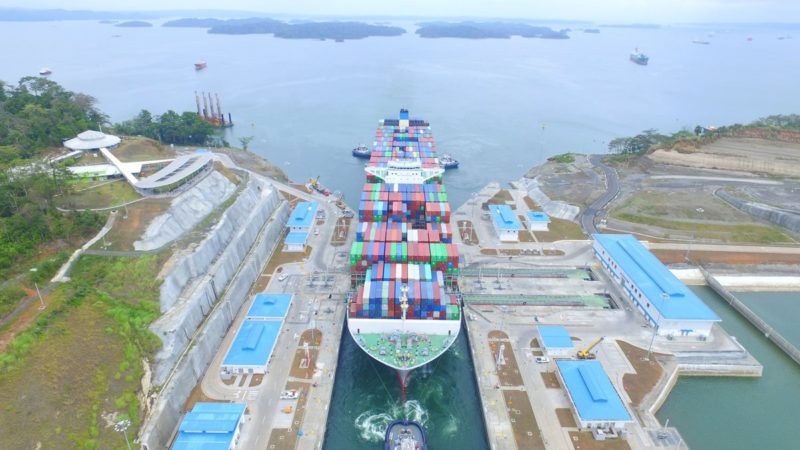OOCL France, the largest ship to use the waterway, transits the Expanded Panama Canal, May 25, 2017. Photo: ACP/Edelman
The Panama Canal Authority (ACP) has published a proposal for modifications to its current toll structure that it says will allow the waterway to continue providing competitive service to customers.
The proposal signals the beginning of a 30-day formal consultation period for industry feedback.
During the past few months, Panama Canal Administrator Jorge L. Quijano and executives met with Panama Canal customers and industry representatives in Europe, Asia and North America to discuss the proposed changes.
“These meetings with customers in Asia, Europe and North America have been extremely valuable in providing us with a deeper understanding of the industry today, the challenges faced by individual market segments, and the projected demand for the Neopanamax locks,” said Mr. Quijano.
The current Panama Canal toll structure, which has been in place since April 1, 2016, calls for each vessel segment to be priced based upon different units of measurement. For example, dry bulk vessel tolls are be based on deadweight tonnage capacity and metric tons of cargo; Liquefied Natural Gas (LNG) and Liquefied Petroleum Gas (LPG) vessels are based on cubic meters; tankers are measured and priced on Panama Canal Universal measurement system (PC/UMS) tons and metric tons of cargo; containerships are measured and priced on TEUs; and passenger vessels are based on berths or PC/UMS. The current structure also includes, for the first time, a customer-loyalty program for the container segment, where frequent container customers will receive premium prices once a particular TEU volume is reached.
But after a thorough analysis of the feedback obtained during these meetings with customers, and the current utilization and productivity of the Neopanamax locks, the ACP deemed it was necessary to provide additional incentives to the containership segment-the largest user of the Expanded Canal-to revise the tolls for liquefied petroleum gas (LPG) and liquefied natural gas (LNG) vessels, and to reclassify container/breakbulk vessels.
For the containership segment, the ACP says the proposal offers more attractive rates per loaded containers on the return voyage, applicable only to those Neopanamax vessels deployed on the Canal route in the head and back haul legs, and when the utilization rate of the northbound transit is higher or equal to 70 percent, and the time lapse between the northbound and the southbound transit is not greater than 25 days. In order to promote the use of the services provided by the local transportation hub, any additional days that the vessel requires to perform port-related activities in the Panamanian terminals will not add to the 25 day period, according to the ACP.
The proposal also modifies the tolls charged to LPG and LNG vessels, but keeps the units of measurement unchanged, as they have proven to be in accordance with industry standards. In addition, this tolls proposal reassigns the vessels classified by the ACP as “container/breakbulk” into the “general cargo segment.” These vessels are currently part of the “others segment.”
This reassignment will result in more attractive tariffs for customers in this category, as general cargo tolls are lower. “This change is made in response to a request submitted by customers during the 2015 tolls hearing and consultation process, and due to the fact that container/breakbulk vessels operate in a manner similar to that of general cargo vessels. As in the past, the ACP takes into account the comments received during the tolls consultation processes and makes changes when considered necessary,” the ACP said in a press release.
The modifications were approved by the ACP’s Board of Directors on May 25, 2017.
“The proposed modifications safeguard the competitiveness of the waterway, the value of the route, and facilitates the Canal’s goal of providing an efficient and reliable service to the global shipping community,” added Mr. Quijano.
The proposal, which is publicly available at www.pancanal.com/peajes, is open for public comment through July 3, 2017, with a public hearing set for July 5, 2017. The ACP says that after a careful evaluation and analysis of the comments received, and once any pertinent changes are incorporated in the proposal, the Cabinet Council of the Republic of Panama will officially approve the modifications. The date for implementation of the modifications to the tolls structure is planned for October 1, 2017.
